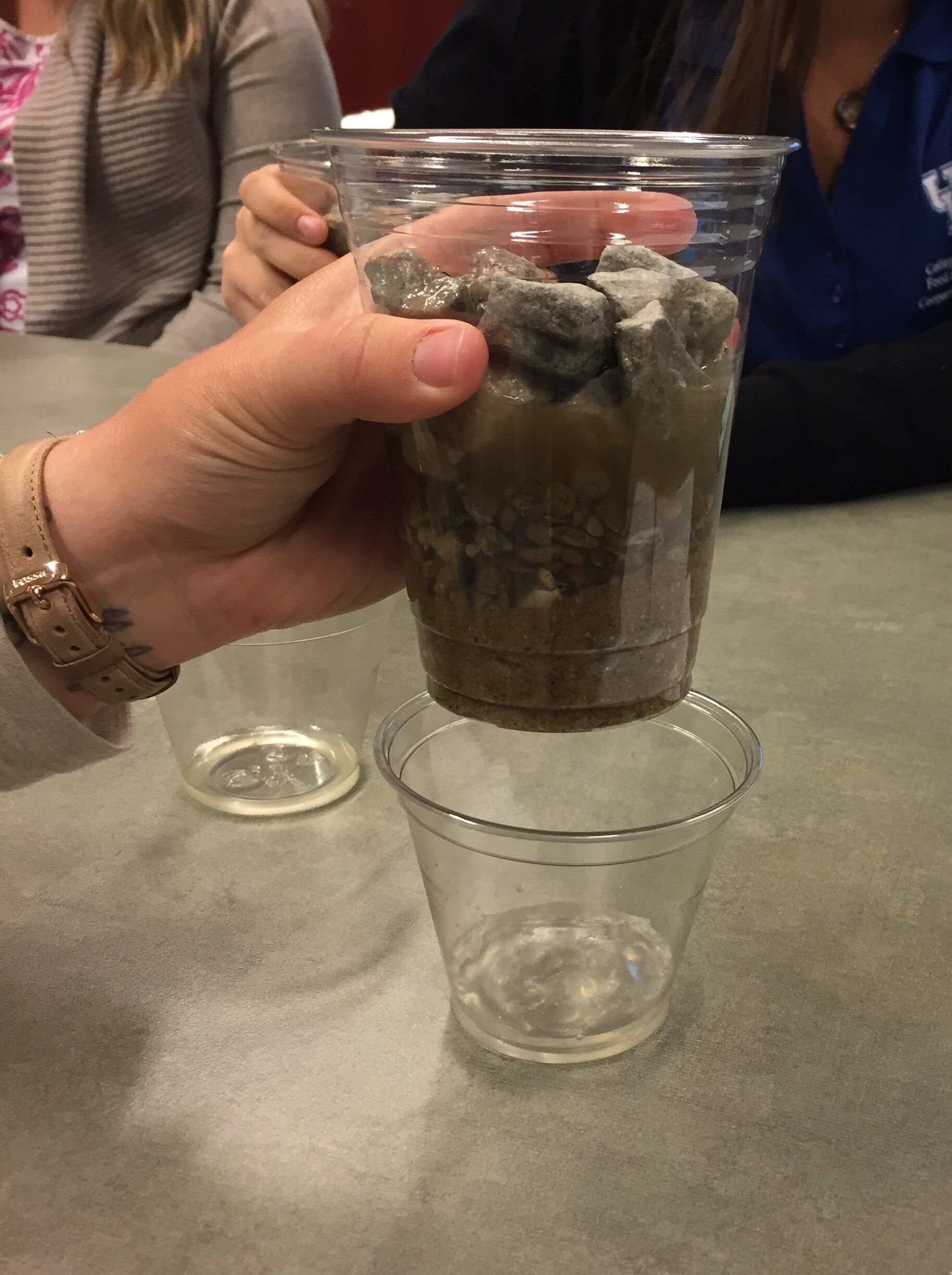Let's Make Clean Water
Students will:
Identify the various parts of the water cycle.
Identify and explain how groundwater is created.
Design and construct an earth system model that will create groundwater.
Kentucky Academic Standards
NGGS
Earth’s Systems
MS-ESS2-4. Develop a model to describe the cycling of water through Earth's systems driven by energy from the sun and the force of gravity.
MS-ESS3-1. Construct a scientific explanation based on evidence for how the uneven distributions of Earth's mineral, energy, and groundwater resources are the result of past and current geoscience processes.
Engineering and Design
Materials
Nail
Clear Plastic Cups or 2 liter bottles
Sand
Water
Small Pebbles
Gravel
Contaminated Water
Vocabulary Sheet & Water Cycle Diagram
“Design a Water Filtration Model” Worksheet
Power Point & Additional Information - Download from Google Drive
Background
Looking at satellite photographs of the planet Earth can illustrate the fact that the majority of the Earth’s surface is covered with water. Earth is known as the “Blue Planet.” Seventy-one percent of the Earth’s surface is covered with water. There also is water beneath the surface of the Earth.
Yet, with all the water present on Earth, water is still a finite source, cycling from one form to another.
This cycle, known as the hydrologic cycle, is an important concept to help understand the water found on Earth.
In addition to understanding the hydrologic cycle, you must understand the different places that water can be found—primarily above the ground (as surface water) and below the ground (as groundwater). Today, we will be starting to understand water below the ground.
Interest Approach
Ask the students wad up a piece of construction paper. Then flatten out the piece of paper. Explain to the students that this represents the land. The high points are like hills/mountains/peaks and the low points are like valleys. Think about a rainfall. Ask the students where the rain will go. Where would rivers be located? Where would lakes be located? Does all the water stay on the surface of the earth?
Procedure
Explain that this paper represents a watershed. A watershed is the area of land where all of the water that falls in it and drains off of it goes into the same place. A watershed includes all plants, animals, and people that live in that area, as well as non-living components such as soil and rocks.
Water that is part of a watershed either becomes surface water or groundwater. Surface water is water on the surface of the land in places like rivers, lakes, oceans, creeks, etc.
Groundwater is water that collects or flows beneath the Earth's surface, filling the porous spaces in soil, sediment, and rocks. Groundwater originates from rain and from melting snow and ice and is the source of water for aquifers, springs, and wells.
Surface water and groundwater are important parts of the hydrological cycle. This cycle is more commonly known as the water cycle. The water cycle is the cycle of processes by which water circulates between the Earth's oceans, atmosphere, and land, involving precipitation such as rain and snow, drainage in streams and rivers, and return to the atmosphere by evaporation and transpiration.
Both surface water and groundwater can be contaminated by animal waste, human waste, eroding soil, and other types of contaminants. These types of contaminants can be visible in surface water. Although groundwater can be contaminated, it is generally more clear than surface water. This is evident by looking at water from a natural spring. Why? How does the earth act as a natural water purifier? What components within the earth act as a filter for water?
Spring water results from filtration through hundreds of feet of sediment, sand, and gravel — a thorough and extremely slow process. Experts estimate that water moves through most natural sediment filters at a rate of less than 0.1 gallon (0.4 liter) per minute for every square foot of area. As it moves through these layers, solids suspended in the water are trapped in the sediments. Disease-causing microorganisms, such as bacteria, are also trapped, and either die naturally or become food for microorganisms that live in the sediment. In the end, the water that bubbles out of artesian springs or is pumped from aquifers several hundred feet below the surface is on average more than 99.9 percent free of contaminants.
Spring water is extremely clean, but sometimes difficult to find or must be pumped up from an aquifer (well). Surface water is readily available, but often contains contaminants. Using three materials (sand, small pebbles, and larger gravel) design a water filtration model that functions like the natural layers within the earth to filter surface water. Use the WORKSHEET to design the filtration system.
After the design is complete, gather all the needed materials to build the water filtration system. Using a nail, poke 3-4 holes in the bottom of the plastic cup. Begin layering the materials into the cup. Have another empty cup to collect the filtered water.
Next, pour the “contaminated surface water” (that has been prepared by the teacher) into the top of the cup. Hold the water filter over the extra cup. Make observations about the filtered water.
Allow students to build a second filtration system to improve on their design and filter the water even more.
Discussion Questions Following Activity:
Which material worked best as a filter? Which one worked the least?
Which design was most effective to filter water?
How could this concept apply to reality?
When would be a situation that would require someone to build a water filtration system?
Created by Rachel Wilson, Farm Scholar, LLC for Kentucky Agriculture and Environment in the Classroom.
Adapted from:
National Ground Water Association Lesson
Wad a Watershed Lesson (Minnesota Ag in the Classroom)


